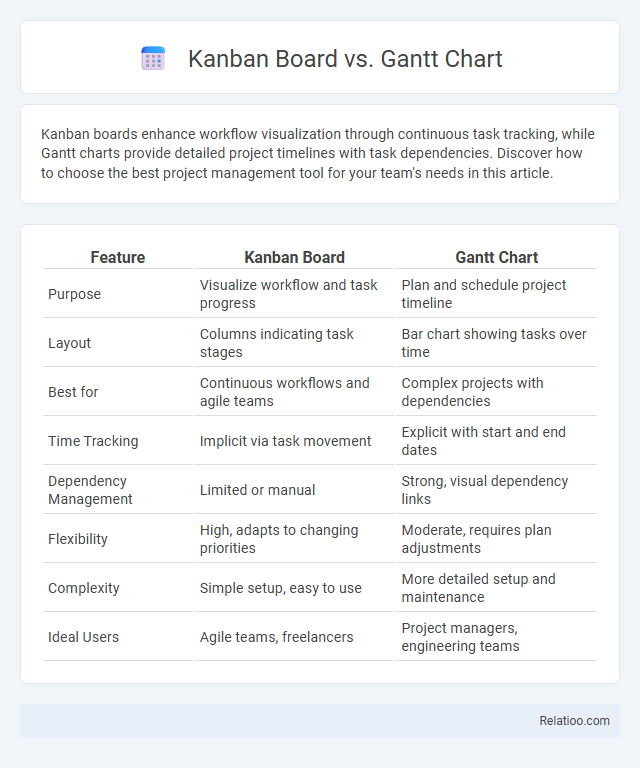Kanban boards enhance workflow visualization through continuous task tracking, while Gantt charts provide detailed project timelines with task dependencies. Discover how to choose the best project management tool for your team's needs in this article.
Table of Comparison
| Feature | Kanban Board | Gantt Chart |
|---|---|---|
| Purpose | Visualize workflow and task progress | Plan and schedule project timeline |
| Layout | Columns indicating task stages | Bar chart showing tasks over time |
| Best for | Continuous workflows and agile teams | Complex projects with dependencies |
| Time Tracking | Implicit via task movement | Explicit with start and end dates |
| Dependency Management | Limited or manual | Strong, visual dependency links |
| Flexibility | High, adapts to changing priorities | Moderate, requires plan adjustments |
| Complexity | Simple setup, easy to use | More detailed setup and maintenance |
| Ideal Users | Agile teams, freelancers | Project managers, engineering teams |
Introduction to Kanban Boards and Gantt Charts
Kanban boards visually represent workflow using cards and columns to track task progress, enhancing transparency and team collaboration. Gantt charts provide a time-based project schedule with bars illustrating task durations and dependencies, making it easier to manage deadlines and resource allocation. Both tools optimize project planning by improving task organization and progress tracking, but Kanban boards excel in agile environments while Gantt charts suit detailed timeline management.
Core Principles: Kanban Boards Explained
Kanban boards emphasize visual workflow management using columns to represent work stages and cards for tasks, promoting continuous delivery and limiting work in progress (WIP) to enhance efficiency. Core principles include transparency, real-time communication, and flexibility, enabling teams to quickly adapt to changes and identify bottlenecks. Unlike Gantt charts, which focus on project timelines and dependencies, Kanban prioritizes flow and incremental progress without fixed schedules.
Core Principles: Gantt Charts Explained
Gantt charts visualize project timelines by mapping tasks against a calendar, highlighting start and end dates with horizontal bars that reveal task dependencies and progress. Unlike Kanban boards which emphasize workflow and task status through columns, Gantt charts prioritize scheduling, resource allocation, and deadline management, making them ideal for projects with fixed timelines. Planning with Gantt charts ensures clarity in task sequencing and critical path identification, enhancing coordination in complex projects.
Visualizing Workflow: Kanban vs Gantt
Kanban boards offer a dynamic, visual workflow with cards that move through customizable columns, making it easy for you to track tasks at various stages of completion. Gantt charts provide a timeline-based visualization, illustrating task dependencies and project milestones to ensure deadlines are met efficiently. Both tools optimize project planning, but Kanban emphasizes continuous flow while Gantt highlights structured scheduling.
Use Cases: When to Choose Kanban Boards
Kanban boards excel in managing workflows for teams requiring continuous delivery, visualizing task progress, and limiting work in progress to enhance efficiency. Your project benefits most from Kanban when prioritizing flexibility, rapid iteration, and collaborative task tracking over strict deadlines or sequential phases. Unlike Gantt charts suited for complex project timelines, Kanban is ideal for agile environments and team-based task prioritization.
Use Cases: When to Choose Gantt Charts
Gantt charts excel in project management scenarios requiring detailed timeline visualization and task dependencies, making them ideal for complex projects with strict deadlines and multiple phases. They provide clear oversight of project progress, resource allocation, and milestone tracking, which is essential for construction, software development, and event planning. When precise scheduling and sequential task management are crucial, Gantt charts outperform Kanban boards and simple planning tools by offering a comprehensive, time-based project roadmap.
Flexibility and Adaptation in Project Management
Kanban boards offer exceptional flexibility by visualizing workflow and allowing You to adapt tasks in real-time through continuous updates, making them ideal for dynamic project environments. Gantt charts provide a structured timeline with dependencies that excel in detailed planning but can be less adaptable to sudden changes. Effective project management often combines Kanban's adaptability with Gantt's strategic overview to balance planning precision and flexible execution.
Collaboration and Team Communication
Kanban boards enhance collaboration and team communication by providing a visual workflow that allows Your team to track tasks in real time, facilitating transparency and quick updates. Gantt charts, with their timeline-based structure, improve coordination by clearly outlining project schedules and dependencies, helping teams align on deadlines and milestones. Using a planning tool that integrates both methods can optimize communication by combining task visibility with time management, ensuring Your team stays synchronized throughout the project lifecycle.
Tracking Progress and Managing Deadlines
Kanban boards excel in visualizing workflow and tracking progress through task cards moving across columns, making it easy for you to identify bottlenecks and prioritize work in real-time. Gantt charts provide a timeline-based view of project tasks and dependencies, offering precise deadline management and milestone tracking for complex projects. Combining both tools enhances project planning by aligning task progress with scheduling, improving overall deadline adherence and resource allocation.
Choosing the Right Tool: Kanban Board or Gantt Chart?
Choosing between a Kanban board and a Gantt chart depends on project complexity and workflow visualization needs. Kanban boards excel at managing continuous tasks with a focus on task status and team collaboration, making them ideal for agile environments and iterative processes. Gantt charts provide detailed timelines and dependencies, better suited for linear projects with fixed deadlines and resource allocation.

Infographic: Kanban Board vs Gantt Chart
 relatioo.com
relatioo.com